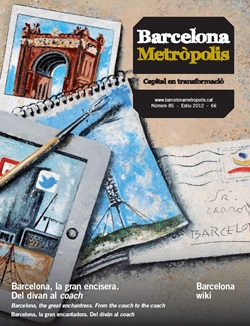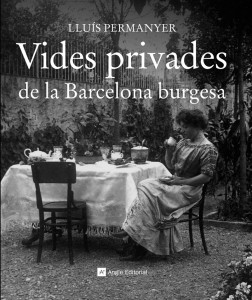Vides privades de la Barcelona burgesa
Lluís Permanyer
Angle Editorial
Barcelona 2011
272 pages
In one of the over 200 photos in Vides privades de la Barcelona burgesa [Private Lives of Barcelona’s Middle Class], renowned photographer Pau Audouard immortalises the chocolate industrialist, Antoni Amatller – himself an accomplished photographer – having lunch with his daughter Teresa, with one maid waiting on them and another looking on, in the lavish dining room of the house on Passeig de Gràcia, designed by Puig i Cadafalch, which bears the family name. A second photo shows the same characters being borne across the Egyptian desert on a pleasure trip which very few could afford.
Most of these photos, taken from private collections, reveal how wealthy families, regardless of how deeply committed they may have been politically and socially, lived out their lives (including their whims) with a very marked class consciousness. This schism was probably further accentuated when the walls were demolished: the mental distance already existing between them and those who toiled in hardship was compounded by a physical separation. It is true that the middle class had hardly borne the brunt of a stifling life in one of Europe’s most densely populated and unhealthiest cities, but even so, it did all the groundwork, as, it goes without saying, there was a lot to be gained. It knew that there would be 200,000 hectares to exploit or, in other words, a new city would be there to welcome it with open arms. The opportunity was far too good to be missed.
The outcome is basically what is explained, very pleasantly so, throughout this book, which uncovers certain aspects of private life, deeply rooted customs, the odd eccentricity and some unexpected apparitions (or is the vision of Pau Casals with a cigar in one hand and a tennis racket in the other not an oddity?).
In another recent book, published for the 150th anniversary of the Cerdà Plan, Lluís Permanyer, Barcelona journalist, writer and chronicler, did not mince words in his appraisal of the role of the middle class during the selection process of the plan for Barcelona’s Eixample district. As he tells us, the aforementioned class had received the engineer’s proposal with utmost disdain, citing aesthetic and city planning needs, some verging on the absurd. However, their true concern lay in the fact that the egalitarianism championed by a utopian socialist like Cerdà, determined to prioritise the quality of life of all citizens, might impinge upon their speculation plans.
At the time when Vides privades de la Barcelona burgesa picks up, nobody was arguing against a reform which, while it utterly failed to take Cerdà’s more visionary ideas into account, at least managed to preserve one of the territory’s good things: it did not and never would resemble la Bonanova. A plethora of mansions and small palaces were built, albeit alongside modest rented housing, the occasional industry and numerous shops. Interaction between unequal citizens was therefore inevitable, and in all likelihood nurtured the desire for a place zealously reserved for friends and family: the house. This was greatly facilitated by the advent of a movement, modernisme, which spawned the construction of brand-new buildings, decorated according to the burgeoning trends. Permanyer cites the examples of the so-called gallery and the doorway.
If l’Eixample (like la Rambla), its avenues – particularly Passeig de Gràcia – and the pompous facades designed by renowned professionals, were ideal in that they afforded the middle class public exposure and enabled them to act as such (lapsing, if necessary, into the Spanish tongue in on-the-street conversations, or showing off the mistress at the opera), the private setting became the best possible scenario for acting out rituals which were obligatory for that class (hiring wet nurses, receiving guests in the living room or having a piano, which was not necessarily used) and their religious morality (sending auntie off to chaperone young lovers or inviting a poor person to Christmas dinner).
Hence, good breeding prevailed indoors, although certain concessions were made in many homes. For simple entertainment – as being rich did not spare one from boredom – the ladies and gentlemen staged plays suitable only for friends and family, and often organised fancy-dress balls or, more sporadically, spiritualism sessions.
However, rather than conjecture on what awaited them in the afterlife, their concern focused more on whether their status would be maintained on reaching that final destination. So much so that La Vanguardia, as Permanyer reminds us, became the daily newspaper “one had to die in”: for years, death notices, the larger the better, commanded the newspaper’s front pages, relegating the real front-page news to the fifth or seventh pages.




